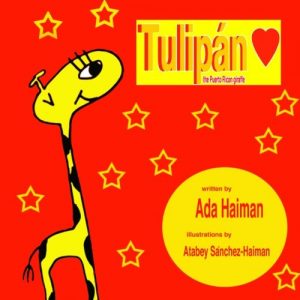 Tulipán: The Puerto Rican Giraffe
Tulipán: The Puerto Rican Giraffe
Written by Ada Haiman
Illustrated by Atabey Sáchez-Haiman
La Jirafa Tulipán, 2014, 44 pp.
ISBN-13: 978-0615924083
Some people think Tulipán does not look Puerto Rican. She thinks it could be her long neck, her big eyes, or her spots. She wonders, “What does it mean to be Puerto Rican? Is it in my blood or in my mind and heart?” She compares and contrasts experiences in both of her beloved homes: Aibonito, Puerto Rico and the Bronx, New York, “one cold, one hot, one city, one country.” She also describes how being bilingual and “Nuyorican” (both New Yorker and Puerto Rican) have given her access to more than one world — “When you leave the metropolitan San Juan and go inland, that’s called ‘going to the island’ although it is all part of the same island. If you are not Puerto Rican, that can be confusing.” Tulipán’s exploration ends when she realizes that “there can be more than one you” and what truly matters are the stories you live. But her journey is just starting.
Picture books published in the United States portraying the experience of Puerto Ricans are limited. Many times, these books overuse national symbols such as the coquí (a small frog indigenous to Puerto Rico) in order to look and sound Puerto Rican. While a coquí can be representative of many Puertorriqueños, it can also lead to oversimplifying the complexities of being Puerto Rican. Tulipán can support readers in challenging narrowed understandings about culture. From Tulipán’s perspective, what matters are her experiences navigating multiple interconnected cultural communities, and how she can use language to name and understand those experiences. Her new understandings about culture are similar to a funds-of-knowledge approach, which describes historically accumulated and culturally developed bodies of knowledge, skills, and family practices essential for household or individual functioning and wellbeing, rather than being confined to static notions of culture.
Tulipán uses comparison/contrast to make sense of a wide range of experiences around landscapes, music and rhythms, weather, and languages. These initial observations can serve as starting points for in-depth explorations around cultural connections and differences between life in the Bronx (and United States broadly) and life on the island of Puerto Rico.
Tulipán: The Puerto Rican Giraffe can be paired with other Latino books about cultural identity, such as René Has Two Last Names by René Colato Laínez (2009) and Marisol McDonald Doesn’t Match by Monica Brown (2011). Both stories describe children’s self-determination in exploring and understanding themselves and their multicultural contexts.
Tulipán can also be paired with additional stories that describe Puerto Rican experiences on the East Coast like Grandma’s Gift by Eric Velasquez (2013) and Sofi and the Magic, Musical Mural by Raquel Ortíz (2015), and stories set on the island like Mis Abuelos y Yo/My Grandparents and I by Samuel Caraballo (2003) and The Coquí and the Iguana by Alidis Vicente (2011). Both texts describe relationships, between a boy and his grandparents and between humans and nature.
Ada Haiman is a retired professor from the University of Puerto Rico, Río Piedras. She wrote Tulipán: the Puerto Rican Giraffe after her daughter’s giraffe prints were rejected by the Puerto Rican Museum of Contemporary Art in 2004 because “giraffes were not Puerto Rican.” Prior to the written text, Haiman shared the story orally at community events. Her audience, including Puerto Ricans who have never left the island, constantly shared personal connections and stories about not looking Puerto Rican enough. These personal accounts inspired Haiman to revisit and publish Tulipán.
The author lived in the Bronx during her childhood and utilized these experiences and her expertise in linguistics and literacy analysis to carefully include words throughout the story that could capture the experience of Puerto Ricans in her neighborhood. Still, Latino families from other countries might also identify with some of those words. For example, chévere (slang for “cool”) is also used in Venezuelan communities, and guagua (slang for “minibus”) exists in Canarian, Dominican, and Cuban Spanish. Other stories by Haiman include Tulipan the Puerto Rican Giraffe Thinks about Grades (2016).
Atabey Sánchez-Haiman’s artistic technique involved illustrating on paper, transferring the drawings to the computer, and coloring the illustrations digitally. Sánchez-Haiman uses concrete images such as a giraffe, musical notes, a bus, and a light bulb to create a highly symbolic and abstract visual story. For example, the light bulb represents ideas and the intellectual, which emerge or are fostered at the university. A pointing finger has multiple meanings. Initially it questions Tulipán’s identity. Later, it indicates a location, followed by a path to La Marqueta, an outdoor market in East Harlem. Towards the end, the pointing finger (along with the light bulb) indicates the emergence of a new awareness and a content Nuyorrican giraffe. Sánchez-Haiman’s work can be followed on www.giraffesandrobots.com.
María Acevedo, University of Massachusetts, Boston, MA
WOW Review, Volume IX, Issue 1 by Worlds of Words is licensed under a Creative Commons Attribution-NonCommercial-ShareAlike 4.0 International License. Based on work at https://wowlit.org/on-line-publications/review/ix-1/
